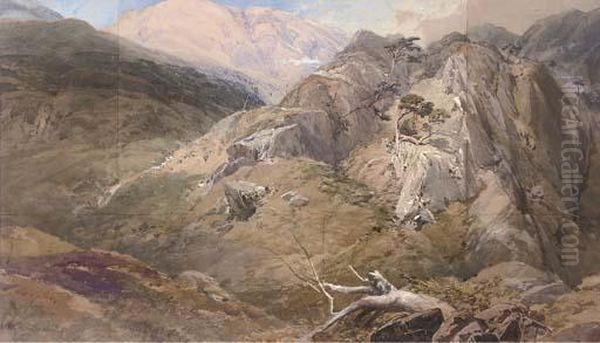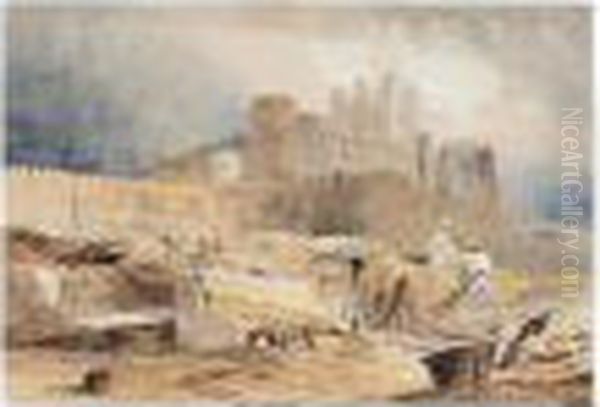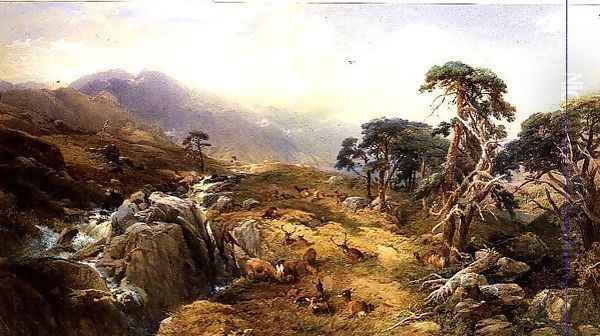Thomas Miles Richardson the Elder stands as a significant figure in the rich tapestry of 19th-century British watercolour painting. Born in Newcastle upon Tyne on May 15, 1784, he carved a distinct niche for himself through his evocative and technically brilliant depictions of the landscapes of Northern England, Scotland, and continental Europe. His life journey, from trade apprenticeships to educational leadership and ultimately to celebrated artist, reflects a determined pursuit of artistic expression during a period of great change and flourishing in British art. He is often distinguished from his equally talented son, Thomas Miles Richardson the Younger, who largely continued his father's artistic legacy.
Early Life and Artistic Beginnings in Newcastle
Richardson's roots were firmly planted in Newcastle. His father, George Richardson, was the respected headmaster of St. Andrew's Grammar School, suggesting an environment where education was valued. However, young Thomas's initial path was not directly towards the arts in a formal sense. His father initially intended for him to pursue a career as an engraver, a craft requiring fine draftsmanship. Following this, he was apprenticed to a cabinet maker, learning skills in woodworking and design.
He completed his five-year apprenticeship in cabinet making but found the trade unfulfilling. This period, however, likely honed his eye for detail and structure. Seeking a different direction, Richardson turned to teaching, a profession perhaps influenced by his father's career. His aptitude was evident, as he eventually succeeded his father, serving as the headmaster of St. Andrew's Grammar School from 1806 until 1813. This period provided financial stability but ultimately could not contain his burgeoning passion for painting.
The Turn to Professional Artistry
Around 1813, Richardson made the pivotal decision to resign from his headmaster position and dedicate himself entirely to art. This was a bold move, stepping away from a secure profession into the less certain world of a professional artist. However, it coincided with a period when watercolour painting was gaining unprecedented popularity and status in Britain, moving beyond mere topographical recording towards expressive, exhibition-worthy art. Artists like J.M.W. Turner and Thomas Girtin had already elevated the medium considerably.

Richardson appears to have been largely self-taught as a painter, developing his skills through rigorous observation and practice. His earlier training in engraving might have provided a foundation in line work, while his time as a teacher perhaps fostered discipline. He quickly developed a distinctive style, particularly in watercolour, which would become his primary medium. He began exhibiting his work locally, gradually building a reputation within the Newcastle art community.
Founding Father of the Newcastle Art Scene
Richardson was not content merely to practice his art; he became a driving force in the cultural life of Newcastle. He played a crucial role in the establishment of the Northumberland Institution for the Promotion of the Fine Arts in 1822, serving as a vital platform for local artists to exhibit their work and engage with the public. This initiative demonstrated his commitment to fostering artistic talent in his native region.
He exhibited frequently at the Institution, showcasing his developing talent alongside other notable Newcastle artists, such as the marine painter John Wilson Carmichael. Richardson's early works often focused on local views, capturing the character of Newcastle and the surrounding Northumbrian landscape. His dedication helped elevate the status of the arts in the North East, creating a more vibrant environment for artists and art lovers alike. He also ran a private art academy with his brother George Richardson (who also became an artist), further contributing to art education in the city.
Mastery of Watercolour
Thomas Miles Richardson the Elder achieved remarkable proficiency in watercolour. His technique was characterized by a combination of broad, atmospheric washes and meticulous attention to detail. He skillfully manipulated the transparency of watercolour to create effects of light, air, and distance, often favouring panoramic compositions that captured the sweep and grandeur of the landscape.
He was adept at rendering complex textures, from rugged rock faces and turbulent water to delicate foliage and architectural details. Richardson often incorporated bodycolour (gouache, or opaque watercolour) to add highlights and texture, a common practice among watercolourists of the period seeking greater solidity and brilliance. Techniques like scraping out highlights from the paper surface were also employed to depict sparkling light on water or snow. His command of the medium allowed him to convey both the picturesque beauty and the sublime power of nature, aligning him with the broader Romantic movement in art.
Subject Matter: The British Landscape

While his travels would later take him further afield, the landscapes of Northern Britain remained a cornerstone of Richardson's oeuvre. He possessed a deep affinity for the scenery of Northumberland, the Lake District, and particularly Scotland. His depictions of the Scottish Borders and Highlands are among his most celebrated works, capturing the dramatic mountains, lochs, and glens with sensitivity and flair.
Works like Newcastle from Gateshead Fell demonstrate his ability to combine topographical accuracy with atmospheric effect, presenting a familiar view imbued with artistic vision. Barras Bridge, another Newcastle scene, further illustrates his engagement with his local environment. His Scottish views, such as depictions of Glen Nevis, showcase his talent for capturing the wild, romantic character of the Highlands, often emphasizing dramatic weather conditions and the interplay of light and shadow across the expansive terrain. These works resonated with contemporary audiences fascinated by the rugged beauty of Britain's northern reaches, popularized by writers like Sir Walter Scott.
Continental Journeys and Alpine Views
Like many British artists of his time, Richardson sought inspiration beyond the shores of the British Isles. He undertook sketching tours on the Continent, particularly drawn to the dramatic landscapes of Italy and Switzerland. The Alps, with their towering peaks, glaciers, and picturesque valleys, offered subjects perfectly suited to the Romantic sensibility he cultivated.
His travels provided a wealth of new material, resulting in numerous watercolours of Italian lakes, Swiss mountains, and Rhineland castles. These continental views often display the same technical brilliance and atmospheric depth as his British scenes, but with the added exoticism and grandeur associated with Alpine scenery. In 1838, he published Sketches on the Continent, a volume containing twenty-six lithographed plates based on drawings made during a tour in 1837. This publication helped to disseminate his work and further enhance his reputation as a versatile landscape painter.
Exhibitions and Recognition
Richardson actively sought recognition through London's major exhibition venues. While he was a central figure in Newcastle's art scene, success in the capital was crucial for national standing. He exhibited works at the Royal Academy, the British Institution, and the Society of British Artists (SBA) in Suffolk Street. His submissions showcased the breadth of his talent, from local Northumbrian scenes to grand Scottish landscapes and picturesque continental views.

It is important to distinguish his exhibition record, particularly concerning the prestigious Society of Painters in Water Colours (the 'Old' Water Colour Society or OWCS), from that of his son. While T.M. Richardson Sr. exhibited widely, it was his son, Thomas Miles Richardson Jr., who became an Associate of the OWCS in 1843 and a full Member in 1851, exhibiting prolifically there for decades. The father's primary London outlets were the RA, BI, and SBA, though his work certainly aligned with the high standards of watercolour painting championed by the OWCS members like David Cox, Peter De Wint, and Copley Fielding.
Artistic Style and Influences
Richardson's style evolved throughout his career but consistently balanced detailed observation with a Romantic feeling for landscape. He shared the era's fascination with the sublime and the picturesque, finding inspiration in dramatic natural phenomena and historically resonant locations. His compositions are often carefully constructed, leading the viewer's eye through layers of landscape towards distant, light-filled horizons. The use of long, narrow formats in some works enhanced their panoramic scope.
While largely self-taught, his work sits firmly within the traditions of British landscape painting. He would have been aware of the foundational work of earlier watercolourists like Paul Sandby and Thomas Girtin, and the innovations of his great contemporaries J.M.W. Turner and John Constable, whose approaches to light and atmosphere revolutionized British art. Comparisons can also be drawn with other prominent watercolourists like John Sell Cotman for his structural clarity, Samuel Prout for his architectural detail, and perhaps even the dramatic intensity found in the work of John Martin, another artist with Newcastle connections. While a snippet suggested influence from the American Hudson River School, this is chronologically and geographically improbable; rather, Richardson shared similar Romantic landscape ideals prevalent on both sides of the Atlantic. His primary context remains the flourishing British school of watercolour.
The Richardson Dynasty: Family and Legacy
Thomas Miles Richardson the Elder founded not just a successful artistic career but an artistic dynasty. Several of his sons followed him into the profession, ensuring the Richardson name remained prominent in the British art world for much of the 19th century. The most famous was Thomas Miles Richardson Jr. (1813-1890), whose style closely resembled his father's, particularly in his detailed watercolours of Scottish and Continental scenes. T.M. Richardson Jr.'s success, especially within the OWCS, sometimes leads to confusion between the two artists' works and careers.

Other sons also pursued art, including George Richardson Jr. (1808-1840), Henry Burdon Richardson (painter and industrial designer), Charles Richardson, John Isaac Richardson (1836-1913), and Edward Richardson (fl. 1845-1869). While varying in prominence, their collective activity underscores the artistic environment fostered within the family. T.M. Richardson Sr.'s influence extended beyond his family, impacting other Newcastle artists and contributing significantly to the development of a regional school of landscape painting. His teaching activities, both at St. Andrew's and his private academy, also played a role in nurturing local talent.
Later Years and Enduring Heritage
Thomas Miles Richardson the Elder remained artistically active until his death in Newcastle on March 7, 1848. He left behind a substantial body of work that continues to be admired for its technical accomplishment and evocative portrayal of landscape. His paintings captured the specific character of the regions he depicted, from the industrial Tyneside to the remote Scottish Highlands and the majestic Alps, reflecting the diverse interests of the Romantic era.
His legacy is preserved not only in the numerous works held in public and private collections but also in his contribution to the cultural life of Newcastle and the broader history of British watercolour painting. Major institutions like the Laing Art Gallery in Newcastle, the Victoria and Albert Museum, and the British Museum in London hold examples of his work, allowing contemporary audiences to appreciate his skill. His paintings remain popular on the art market, testament to their enduring appeal. He stands alongside artists like David Roberts and Clarkson Stanfield as a master of detailed, often topographically inspired, yet romantically infused landscape art. The studio sale mentioned in the snippets occurring at Christie's in 1890 pertains to the estate of his son, T.M. Richardson Jr., not the Elder.
Conclusion
Thomas Miles Richardson the Elder was a pivotal figure in 19th-century British art. Emerging from a background unrelated to fine art, he forged a successful career through talent, dedication, and an astute understanding of the burgeoning market for landscape watercolours. His detailed yet atmospheric depictions of Northern Britain and the Continent earned him significant recognition during his lifetime. As a co-founder of Newcastle's first major art institution and the progenitor of an artistic family, his influence extended well beyond his own canvases. Though sometimes overshadowed by the fame of his son, T.M. Richardson Sr.'s contribution as a master watercolourist and a key regional artist ensures his important place in the annals of British art history. His work continues to offer compelling visions of the landscapes that captivated the Romantic imagination.